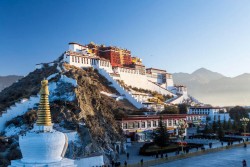You have no items in your shopping cart.


Introducing Jokhang Monastery
Located in the center of the ancient city of Lhasa, the Jokhang Monastery was built in the seventh century by Songtsan Gambo, the Tang Princess Wen Cheng and Nepalese Princess Bhrikuti, in order to promote the Buddhist religion. The temple is regarded as the most sacred and important temple in Tibet.
Jokhang Monastery Fast Facts
• Chinese Name: Da Zhao Si 大昭寺
• Best Time to Visit: May to October
• Recommended Visiting Hours: About 1 to 2 hours
• Things to Do: Photography, Architecture, Tibetan Buddhism
• Opening Hours: 09:00-18:00
• Entrance Fee: CNY 85
• Address: Barkhor Street, Chengguan District, Lhasa, Tibet
What to expect at Jokhang Monastery
Covering 2.5ha in the centre of the old town of Lhasa, it comprises an entrance porch, courtyard and Buddhist hall surrounded by accommodation for monks and storehouses on all four sides. Jokhang Monastery’s four story main building demonstrates a combination of the Han, Tibetan, Indian and Nepalese architectural styles, as well as a man - made world outlook of Buddhism. With the Hall of Amitayus Sutra as its center, the monastery symbolizes the nuclear to the universe. The Hall of Sakyamuni is the essence of Jokhang Monastery. It houses over 3,000 images of Buddha and other deities and historical figures along with many other treasures and manuscripts. Mural paintings depicting religious and historical scenes cover the walls.
Jokhang is the spiritual center of Tibet, the Holy of Holies, the destination of millions of Tibetan pilgrims. Unlike the lofty Potala, the Jokhang has intimate, human proportions, bustling with worshippers and redolent with mystery. The outer courtyard and porch of the temple are usually filled with pilgrims making full-length prostration towards the holy sanctum. Its innermost shrine contains the oldest, most precious object in Tibet - the original gold stature of Sakyamuni - the historical Buddha, which Princess Wen Cheng brought from Chang'an 1,300 years ago.
It was said that Nepal Princess Tritsun decided to build a temple to house the Jowo Sakyamuni aged 12 brought by Chinese Princess Wencheng. Princess Wencheng reckoned according to Chinese astrology that the temple should be built on the pool where the Jokhang now locates. She contended that the pool was a witch's heart, so the temple should be built on the pool to get rid of evils. The pool still exists under the temple. Then goats were used as the main pack animals, as is the reason the city is called Lhasa. The construction took 12 months. However Jokhang Monastery was originally small and had been expanded to today's scale in later dynasties. When the Fifth Dalai Lama took reign, large-scale reconstruction and renovation had been done. The temple is a combination of Han, Tibetan and Nepalese architectural techniques. Visitors will see sphinx and other sacred sculptures.
Every year, the Great Prayer Festival will be held in the Temple. The rites of Dalai Lamas and Panchen Lamas' initiation into lamahood are also held in Jokhang Monastery.
How to get to Jokhang Monastery
• By Bus: take bus No. 7, 8, 20, 22, 23, 25, 28 or 29 and get off at Chongsaikang Station.
• Rent a car/bus from GGC to enjoy a hassle free private transfer from hotels in Lhasa to Jokhang Monastery.
Additional travel advice on Jokhang Monastery
Tibet Travel Permit
• Independent travel is prohibited in Tibet. Foreigners need Tibet Travel Permit to enter Tibet.
• The only way to get Tibet Travel Permit is to join an organized group or have a private tour arranged by a travel agency.
• Tibet Travel Permit is issued by the Tourism Bureau of Tibet Autonomous Region, two weeks prior to the entry of Tibet.
• A valid China Visa is required to apply for Tibet Travel Permit, Get your China Visa at least a month before your trip.
• GoGrandChina will apply for your Tibet Travel Permit once you book Tibet tours with us.
Altitude Sickness
• With an average elevation over 4,000 meters, a mild Altitude Sickness on the first day(s) in Tibet is quite common.
• Try to avoid catching a cold before enter into Tibet.
• Make sure to get a good night's sleep the night before flying to Lhasa.
• Avoid strenuous activity during your first day in Tibet.
• Better drink more water.
• When arriving in Lhasa, walk slowly, take deep breaths. Take time to acclimatize.
• Ascend to higher altitudes gradually. DO NOT ASCEND ANY HIGHER if you begin feeling ill.
• Prepare AMS medication, in accordance with a doctor's advice.
Other Tips
• Jokhang Temple is a religious site, so visitors should dress modestly, behave with good manner. Do not talk too loud. Do not smoke inside the temple.
• It is not allowed to take photos in some chapels. Please get permission first if you want to take photos in the main chapel.
• Sunglasses and sun cream are always needed to protect from the sunburn and strong ultraviolet radiation in the daytime.
• Travelling in Lhasa in the spring (February to April), visitors will have chance to witness many interesting festivals, including the Tibetan New Year.